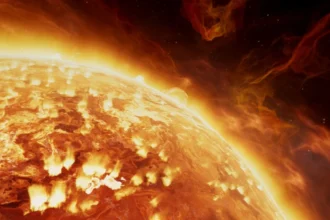South Africa experienced a severe geomagnetic storm classified as G4 on Friday morning, following a coronal mass ejection (CME) from the Sun. The South African National Space Agency (Sansa) confirmed the storm, which impacted GPS and high-frequency communication systems across the country.
The storm was triggered by an Earth-directed CME caused by an X1.8 solar flare on 9 October 2024. Solar flares are classified into five categories—A, B, C, M, and X—with X being the most powerful. This particular X1.8 flare originated from sunspot AR3848, while a second, slightly weaker X1.4 flare was observed from sunspot AR3843 on the same day.
Sansa had issued warnings ahead of the event, predicting a significant geomagnetic impact. These latest flares come just days after another strong geomagnetic storm hit South Africa, during which the Southern Lights, or Aurora Australis, were visible over the country—an exceptionally rare phenomenon.
Solar Activity and Global Impact
Solar storms have been particularly intense recently. Sansa explained that the Sun has shown heightened activity over the past two weeks, with two notable solar flares recorded just before the latest storm. Less than a week earlier, on Thursday, 3 October, the agency recorded the strongest Earth-facing solar flare it had observed in seven years—measuring an astonishing X9.05.
While global forecasts had predicted a G3/Strong geomagnetic storm last weekend, the actual impact only occurred on Monday and Tuesday, classified as G3. These storms can cause disruptions to power grids and create drag on low-Earth orbit satellites, including those used by SpaceX’s Starlink.
Although geomagnetic conditions seemed normal throughout the previous weekend, the delayed storm arrival took researchers by surprise. “The reasons for this delayed storm arrival will be the subject of global research studies,” stated Sansa.
The Current G4 / Severe Storm
On Friday, as the G4/Severe storm began, Sansa released data confirming the geomagnetic disturbance. The agency also noted that global navigation systems like GPS and high-frequency communications faced significant disruptions as a result of the storm. Solar winds were strong, with forecasts predicting further X-class solar flares in the coming days.
Although no new Earth-directed CMEs were observed in the past 24 hours, several smaller flares have been detected. These C- and M-class flares pose little threat but will continue to be monitored for any potential impact.
Sansa also indicated that there are seven visible sunspot regions on the solar disk, with varying magnetic complexities. Some filaments in the solar atmosphere showed movement, suggesting a potential risk for further lift-offs and disruptions.
Solar Maximum Approaching
The Sun is currently approaching the peak of its 11-year solar cycle, known as solar maximum. This period is expected to bring an increase in geomagnetic storms and auroras due to the Sun’s intense activity.
Scientists have observed more than 40 X-class solar flares in 2024 alone, a sharp contrast to the previous nine years, which saw only 36 such events. This increase in solar activity is expected to continue as Earth’s magnetic field becomes more closely aligned with the solar wind. The equinox on 22 September marked a critical point, increasing the likelihood of CMEs hitting Earth and causing geomagnetic storms.
A Growing Concern
South Africa’s recent solar storms serve as a reminder of the potential disruptions that space weather can cause to modern technology. With the Sun becoming more active, the threat to communication systems, navigation tools, and satellites will likely intensify in the coming months.
While Sansa continues to monitor these events closely, the growing frequency of solar flares indicates that the planet is entering a phase of heightened solar activity that could bring more challenges for South Africa and the world.








